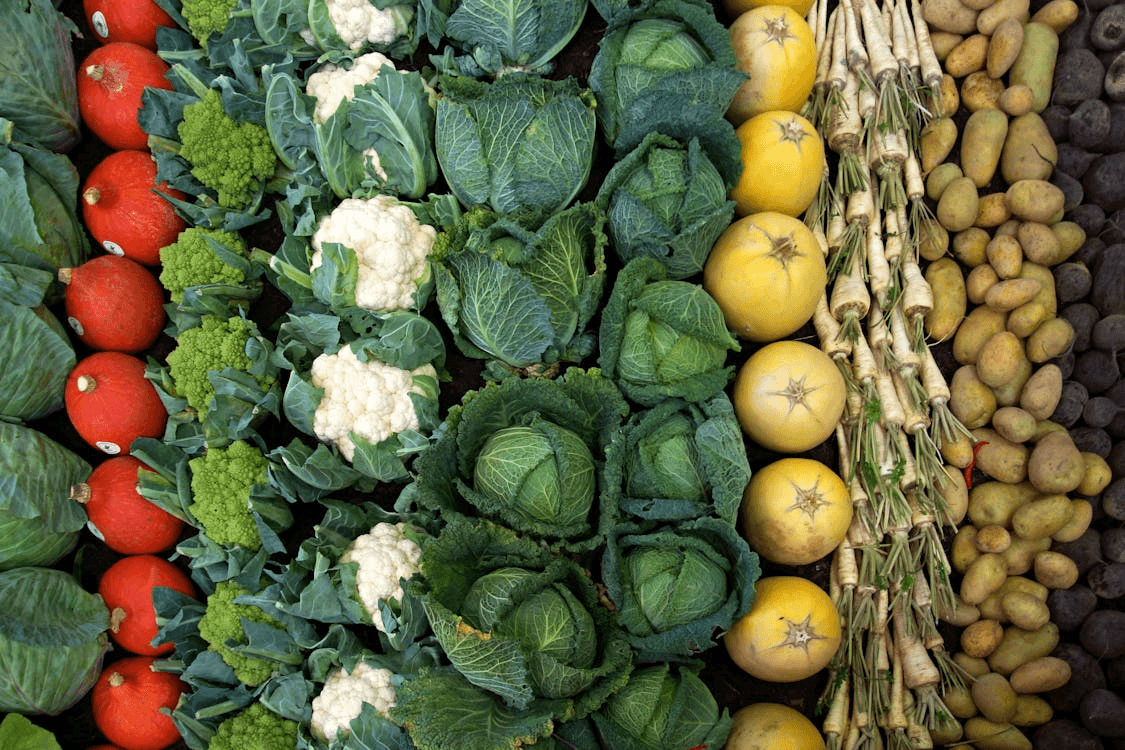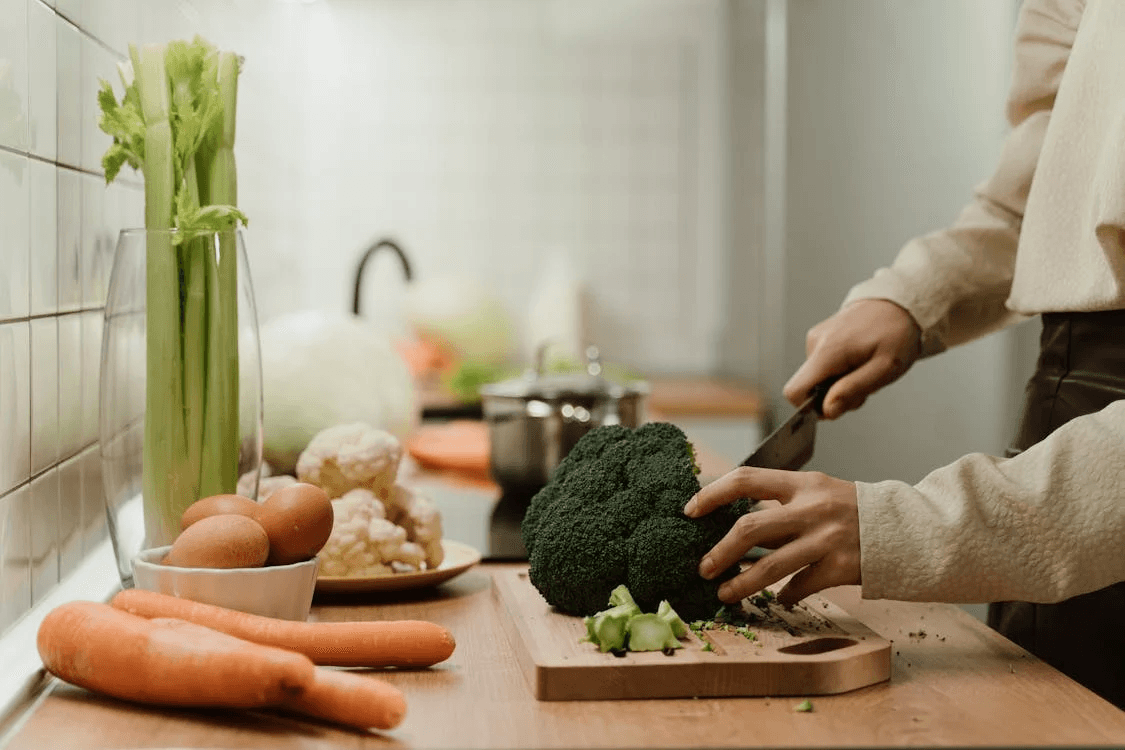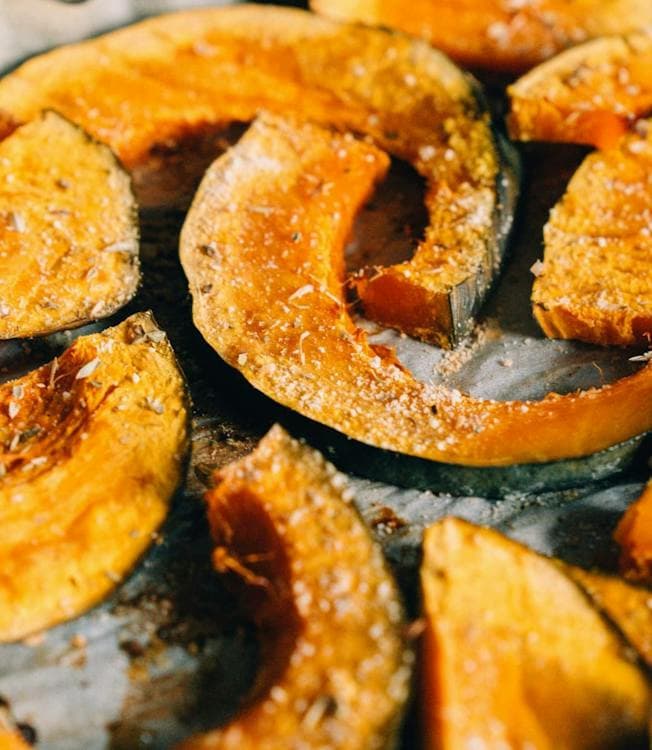Winter can be cold and dreary, but it's a great time for cosying up with warming comfort food. It's also the season of crisp, sunny mornings, leafy walks in the forest, hearty warming meals and delicious wholesome veg. There's a whole harvest of nutritious vegetables in our winter menu - they look good, taste good, and they do you good! Find out how these seasonal beauties can give your body a boost.
Pumpkin and Butternut Squash
Autumn is peak harvest season for pumpkin and the squash family, but once harvested, they keep well through the colder months, so they are often featured in recipes throughout the winter. These glorious orange vegetables taste amazing and are highly nutritious(1), so it's a shame to just use them for Halloween lanterns! They contain high levels of beta carotene, a powerful antioxidant that gives orange vegetables and fruits their vibrant colour. The body converts any ingested beta carotene into immune-boosting vitamin A (2,3). One serving contains only 45 calories and supplies 13% of your daily vitamin C, 10% of your daily fibre, and an array of minerals, including iron and heart-healthy potassium (4). They make a great low-carb alternative to pasta or potatoes too.
Anyone who has tried to carve a Jack-o-lantern will know how difficult pumpkins and squash are to prepare, so it's a relief to know that our chefs have done all the hard work for you. If you want to try cooking with these big orange balls of goodness, then try our top tip: prick the skin and bake your squash or pumpkin for around 15 minutes in the oven. The skin will then peel off super easily - #lifehacks!
Cabbage
Cabbage always seems to get a bad rap. It's associated with weird cabbage soup diets and soggy school lunches. Thankfully, our chefs know how to cook this delicious vegetable properly!
Cabbage contains so many nutrients that it's hard to know where to start singing its praises. It's full of healthy fibre so it's great for your gut health, and chock full of minerals like calcium and potassium (5). However, like the other members of the super-food cruciferous veg family, its superpower is immune-boosting, anti-inflammatory sulforaphane (6,7,8). This natural phytochemical is actually part of this gutsy vegetable's defence mechanism against damage, but when consumed, it has a multitude of health benefits for us. Finally, with a portion of cabbage supplying a whopping 63% of your daily immune-boosting (9) vitamin C requirements, how can you afford NOT to eat it?!

Winter veggies are delicious and nutritious
Cauliflower
Cauliflower is a classic autumn vegetable from the cruciferous veg family. Sadly, like cabbage, poor ol' caulis are often associated with soggy, overcooked Sunday lunches at your Auntie Betty's. Yet when delicately steamed, stir-fried, roasted or curried, the powerful flavour of this versatile veg is truly sublime. Like the rest of the cruciferous crowd, this enigmatic white vegetable is full of fibre and minerals like magnesium. A portion supplies around 61% of your daily vitamin C needs (10), and it's also a great source of vitamin K, which helps to support bone health (11).
Courgettes
Sometimes known as zucchini, courgettes might look like a cucumber's weird cousin, but they're actually another member of the squash family. Courgettes are technically a fruit as they're produced from a beautiful yellow flower, which is also edible.
They're a great low-carb option with only 2.7g carbohydrates per 100g (12), and contain both soluble and insoluble fibre, so they will help to keep you 'going'!
A great source of antioxidants like vitamin C for immune support (9), they also contain lutein and zeaxanthin to support eye health. An average portion contains good amounts of manganese, magnesium, zinc, and 10% of your daily heart-healthy potassium (4).
Swede
A wholesome root vegetable, swede is another unsung hero of the autumn and winter season. You might see it referred to as rutabaga, or 'neeps' in the north of England! It's traditionally served in Scotland with haggis, but its delights are less well-known in the rest of the UK. It's a great low-carb alternative to potatoes and rice, with only 8.6g of carbs per 100g (13). An average portion provides immune support (9) with almost 40% of your recommended daily vitamin C, and 11% of your vitamin B1 (thiamine) supporting a healthy metabolism (14).
Our chefs have created some scintillating swede accompaniments in the following dishes:
Celeriac
This pale, knobbly root vegetable certainly wouldn't win the Most Attractive Autumn Veg contest! It's not typically found on the average shopping list, which is a real shame, as its delicate, complex flavour makes it a favourite with the world's best chefs. With only 5.9g of carbs per 100g (15), it's a great substitute for potatoes, and so versatile - you can eat it raw, stir-fried, boiled, roasted or steamed! It's a great source of B vitamins, especially calming vitamin B6, which keeps the nervous system healthy (16). It also contains immune-boosting vitamin C (9), and a multitude of minerals including phosphorus, potassium and magnesium for post-workout recovery (17).

Let us chop and cook your veg for you!
Broccoli
A renowned 'superfood', broccoli is one of the most nutritious and versatile vegetables in our winter array, being equally at home in a stir fry, pasta, salad, or roast dinner. Another member of the nutrient-dense cruciferous family, broccoli has a most remarkable nutritional profile (18,19). It's a fabulous source of vitamins A and C for immune support (9), B vitamins for healthy skin, hair, nerves and muscles (16); fibre for good gut health, heart-healthy potassium (4), selenium for immunity (20), and iron for energy and overall well-being (21). It also contains bioactive compounds, most notably glucoraphanin, which is converted by the body into a potent antioxidant called sulforaphane. Sulforaphane has been extensively researched and found to offer protective effects against a range of serious health conditions (6,7,8).
Red cabbage
Red cabbage is green cabbage's colourful cousin, but despite its attractive red colouring, this brightly coloured veggie is not as popular as the green varieties, often only used at Christmas or in pickles. This is a great shame as it's highly versatile: you can eat it raw in salads or coleslaw, stir-fried, braised, steamed, or boiled. Whilst all types of cabbage are highly nutritious, red cabbage has the edge over its green counterparts, plus some unique properties which boost its nutritional value even further. It is a great source of gut-healthy fibre and vitamin B6, and has more vitamin C, vitamin A and iron than green cabbage (22,23). Due to its vibrant red colour, red cabbage also contains around 4 times more antioxidants than green cabbage, including powerful plant compounds like carotenoids, flavonoids and sulforaphane, which have been shown to help reduce the risk of serious diseases (24,25).
These are just a few of the scrumptious veggies that our chefs have included in our healthy, hearty winter menu. We make it easy for you to get your daily veg boost as all of our main meals contain at least two of your 'five-a-day' vegetable portions. Winter veggies are delicious and nutritious, but they can be some of the most difficult to peel and prepare. Life's too short to chop veg - let us take the strain, while you make the gains!
Check out the rest of our delicious meals here.
References:
Nutrition facts for cooked pumpkin. myfooddata. (n.d.) https://tools.myfooddata.com/nutrition-facts/16844...
U.S. Department of Health and Human Services. (n.d.). Office of dietary supplements - vitamin A and carotenoids. NIH Office of Dietary Supplements. https://ods.od.nih.gov/factsheets/VitaminA-HealthProfessional/
Huang Z, Liu Y, Qi G, Brand D, Zheng SG. Role of Vitamin A in the Immune System. J Clin Med. 2018 Sep 6;7(9):258. doi: 10.3390/jcm7090258. PMID: 30200565; PMCID: PMC6162863.
Ware LJ, Charlton K, Schutte AE, Cockeran M, Naidoo N, Kowal P. Associations between dietary salt, potassium and blood pressure in South African adults: WHO SAGE Wave 2 Salt & Tobacco. Nutr Metab Cardiovasc Dis. 2017 Sep;27(9):784-791. doi: 10.1016/j.numecd.2017.06.017. Epub 2017 Jul 8. PMID: 28800936.
Nutrition facts for cooked cabbage. myfooddata. (n.d.) https://tools.myfooddata.com/nutrition-facts/16997...
Jiang X, Liu Y, Ma L, Ji R, Qu Y, Xin Y, Lv G. (2018 )Chemopreventive activity of sulforaphane. Drug Des Devel Ther. Sep 11;12:2905-2913. doi: 10.2147/DDDT.S100534. PMID: 30254420; PMCID: PMC6141106.
Fernandez-Prades, L.; Brasal-Prieto, M.; Alba, G.; Martin, V.; Montserrat-de la Paz, S.; Cejudo-Guillen, M.; Santa-Maria, C.; Dakhaoui, H.; Granados, B.; Sobrino, F.; Palomares, F.; Lopez-Enriquez, S. Sulforaphane Reduces the Chronic Inflammatory Immune Response of Human Dendritic Cells. Nutrients 2023, 15, 3405.
Mangla B, Javed S, Sultan MH, Kumar P, Kohli K, Najmi A, Alhazmi HA, Al Bratty M, Ahsan W.(2021) Sulforaphane: A review of its therapeutic potentials, advances in its nanodelivery, recent patents, and clinical trials. Phytother Res. Oct;35(10):5440-5458. doi: 10.1002/ptr.7176. Epub 2021 Jun 28. PMID: 34184327.
Carr AC, Maggini S. Vitamin C and Immune Function. Nutrients. 2017 Nov 3;9(11):1211. doi: 10.3390/nu9111211. PMID: 29099763; PMCID: PMC5707683.
Nutrition facts for cooked cauliflower. myfooddata. (n.d.) https://tools.myfooddata.com/nutrition-facts/170397/wt9/1
Maresz K. Proper Calcium Use: Vitamin K2 as a Promoter of Bone and Cardiovascular Health. Integr Med (Encinitas). 2015 Feb;14(1):34-9. PMID: 26770129; PMCID: PMC4566462.
Nutrition facts for cooked zucchini. myfooddata. (n.d.) https://tools.myfooddata.com/nutrition-facts/169292/wt1/1
Nutrition facts for cooked rutabaga. myfooddata. (n.d.) https://nodetools.myfooddata.com/nutrition-facts/168454/wt1/1
Martel JL, Kerndt CC, Doshi H, et al. Vitamin B1 (Thiamine) [Updated 2022 Oct 12]. In: StatPearls [Internet]. Treasure Island (FL): StatPearls Publishing; 2023 Jan-. Available from: https://www.ncbi.nlm.nih.gov/books/NBK482360/
Nutrition facts for cooked celeriac. myfooddata. (n.d.) https://tools.myfooddata.com/nutrition-facts/169987/200cals/1
NHS. (n.d.). B vitamins and folic acid. NHS choices. https://www.nhs.uk/conditions/vitamins-and-mineral...
Zhang Y, Xun P, Wang R, Mao L, He K. Can Magnesium Enhance Exercise Performance? Nutrients. 2017 Aug 28;9(9):946. doi: 10.3390/nu9090946. PMID: 28846654; PMCID: PMC5622706.
Nutrition facts for cooked broccoli. myfooddata. (n.d.) https://tools.myfooddata.com/nutrition-facts/169967/100g/1
Syed RU, Moni SS, Break MKB, Khojali WMA, Jafar M, Alshammari MD, Abdelsalam K, Taymour S, Alreshidi KSM, Elhassan Taha MM, Mohan S (2023) Broccoli: A Multi-Faceted Vegetable for Health: An In-Depth Review of Its Nutritional Attributes, Antimicrobial Abilities, and Anti-inflammatory Properties. Antibiotics (Basel). Jul 7;12(7):1157. doi: 10.3390/antibiotics12071157. PMID: 37508253; PMCID: PMC10376324.
Huang Z, Rose AH, Hoffmann PR. The role of selenium in inflammation and immunity: from molecular mechanisms to therapeutic opportunities. Antioxid Redox Signal. 2012 Apr 1;16(7):705-43. doi: 10.1089/ars.2011.4145. Epub 2012 Jan 9. PMID: 21955027; PMCID: PMC3277928.
Abbaspour N, Hurrell R, Kelishadi R. Review on iron and its importance for human health. J Res Med Sci. 2014 Feb;19(2):164-74. PMID: 24778671; PMCID: PMC3999603.
Nutrition facts for red cabbage (cooked) myfooddata, https://tools.myfooddata.com/nutrition-facts/169978/wt9/1
Carlsen MH, Halvorsen BL, Holte K, Bohn SK, Dragland S, Sampson L, Willey C, Senoo H, Umezono Y, Sanada C, Barikmo I, Berhe N, Willett WC, Phillips KM, Jacobs DR Jr, Blomhoff R. (2010 ) The total antioxidant content of more than 3100 foods, beverages, spices, herbs and supplements used worldwide. Nutr J. Jan 22;9:3. doi: 10.1186/1475-2891-9-3. PMID: 20096093; PMCID: PMC2841576.
Jennings A, Welch AA, Fairweather-Tait SJ, Kay C, Minihane AM, Chowienczyk P, Jiang B, Cecelja M, Spector T, Macgregor A, Cassidy A. (2010) Higher anthocyanin intake is associated with lower arterial stiffness and central blood pressure in women. Am J Clin Nutr.Oct;96(4):781-8. doi: 10.3945/ajcn.112.042036. Epub 2012 Aug 22. PMID: 22914551.




